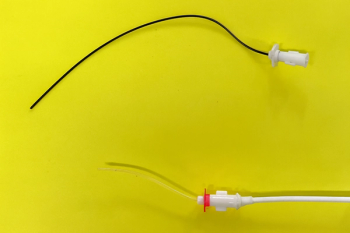
Urine specific gravity measurement and interpretation in veterinary medicine
A look at the indications for this important part of a veterinary urinalysis and how to interpret the results. (Part two of a four-part series)
In the March issue of dvm360 ("How specific is urine specific gravity?"; see the related link below), we asked several questions about urine specific gravity, such as what does urine specific gravity measure? This month, we continue to investigate whether urine specific gravity is really specific.
But first, let us review some of the major points we covered previously. The kidneys excrete unwanted solute (urea, creatinine, minerals and other metabolic garbage) in a volume of water that is not itself required to maintain homeostasis. Elimination of unwanted solutes and water is the result of carefully regulated glomerular filtration, tubular reabsorption and tubular secretion. Serum urea and serum creatinine are predominantly dependent on the glomerular filtration rate (GFR) and, therefore, are used to measure the GFR. So what does urine specific gravity measure? Urine specific gravity is used as a clinical index of tubular function.
Methods of measurement
Measurements of urine specific gravity made by osmometers, refractometers, urinometers and reagent strips are related but not interchangeable. Measurement of urine osmolality provides information that is more closely related to renal concentrating capacity than does specific gravity or refractive index. Osmometers provide more accurate assessment of osmolality of individual urine samples than refractometers or urinometers but are relatively expensive.
As mentioned, urine specific gravity is a direct but not proportional function of the number of solute particles in urine. Urine specific gravity varies with the kind of solute present, whereas urine osmolality is independent of the types of solute present. Therefore, urine specific gravity provides only an estimation of osmolality. Indirect measurement of urine specific gravity by refractometry is useful as a screening test of renal function. Urine osmolality measured with an osmometer should be used for patients with undiagnosed persistent polyuria when errors in assessment of renal function are of significant consequence. Vapor pressure osmometers are preferable to freezing point osmometers when assessing urine samples with high osmolality.
Evaluation of urine specific gravity is essential when interpreting test results of the complete urinalysis. Refractometers are recommended over urinometers for determination of urine specific gravity because they provide more reproducible results, require a small sample size, are temperature-compensated and are technically easy to use.
Indications
Measurement of urine osmolality, either directly by osmometry or indirectly by evaluation of urine specific gravity, is the primary method used to evaluate the kidney's "response ability" to concentrate (remove water in excess of solute) or dilute (remove solute in excess of water) urine. Thus, evaluation of urine osmolality or specific gravity is an index of tubular reabsorption. Knowledge of urine osmolality or specific gravity is also extremely helpful when attempting to differentiate among the underlying causes of polyuria and when localizing the pathophysiologic mechanisms of azotemia (Table 1).
Table 1 Differentiation of different forms of azotemia
Routine evaluation of urine specific gravity involves interpretation of tests that are part of the complete urinalysis. Interpretation of other test results of the urinalysis depend on knowledge of specific gravity (or urine osmolality) since these data provide information regarding the ratio of solutes to solvent (water). Tests of routine urinalyses are typically performed on a relatively small sample of urine without regard to the rate of formation of urine or total urine volume. Semiquantitative interpretation of results is unfeasible in such samples without knowledge of specific gravity.
Consider proteinuria as an example. Does 2+ proteinuria at a specific gravity of 1.010 reflect an equal or greater loss of protein than a 2+ proteinuria at 1.050? The answer is obvious—there is more protein in the less concentrated sample. The same concept is applicable to interpretation of positive test results for glucose, ketones, bilirubin, occult blood and constituents in urine sediment.
Another indication for evaluation of urine specific gravity or osmolality is as an aid for monitoring the patient's fluid balance, especially during therapy with parenteral fluids.
Interpretation
The root word sthen is Latin for the English word strength. Hypersthenuria, hyposthenuria and isosthenuria are terms that depict the solute concentration (or strength) in urine compared with the concentration of solute in glomerular filtrate:
- Hypersthenuria (also called baruria) depicts urine of high specific gravity and osmolality compared with glomerular filtrate.
- Hyposthenuria depicts formation of dilute urine with a specific gravity and osmolality that are significantly lower than those of plasma and glomerular filtrate.
- Isosthenuria depicts urine with a specific gravity and osmolality similar to those of (or with the same strength as) plasma and glomerular filtrate.
Complete loss of the ability to concentrate or dilute glomerular filtrate according to body need is sometimes referred to as fixed specific gravity.
In the context of quantifying urine concentration, terms that are more useful than hypersthenuria are 1) maximum urine concentration, 2) functionally adequate urine concentration and 3) inappropriate urine concentration (Table 1). There is significant species variability in maximum and functionally adequate urine concentrating capacities.
Osmotic activity in extracellular fluid and urine
Sodium, chloride and bicarbonate account for about 90 percent of the osmotic activity of extracellular fluid. Nonelectrolytes such as urea, proteins and glucose account for the remainder of the osmotic activity (10 percent). Sodium, chloride and urea account for most of the osmotic activity in urine.
There is usually no significant difference between the osmolality (specific gravity) of uncentrifuged urine and of centrifuged urine because cells, casts and os on do not contribute significantly to osmotic pressure. There is no significant difference between serum and plasma osmolality since fibrinogen does not exert a significant osmotic effect. However, the quantity and type of anticoagulant used to obtain plasma may be of significance. For example, EDTA may contribute 5 to 20 mOsm/kg to plasma osmolality, depending on the amount of blood in a 2-ml Vacutainer (BD) tube. Heparin is usually used as the anticoagulant for plasma osmolality determinations.
Normally the osmotic concentration of urine is variable, depending on the fluid and electrolyte balance of the body and the nitrogen content of the diet. Species differences in the ability to concentrate urine are also significant (Table 1). Interpretation of urine osmolality is usually enhanced when the values of serum or plasma osmolality are also available. The osmotic concentration of plasma, serum, interstitial fluid and transcellular fluid is about 280 to 310 mOsm/Kg of water. The osmotic concentration of glomerular filtrate is about 300 mOsm/kg of water. The ratio of urine osmolality to plasma osmolality (U/Posm) is a good clinical index of the ability of the kidneys to concentrate or dilute glomerular filtrate.
- A U/Posm ratio above 1 indicates that the kidneys are concentrating urine above plasma and glomerular filtrate. After water deprivation, the U/Posm of normal dogs may be 7 or higher.
- A U/Posm ratio of about 1 indicates that water and solute are being excreted in a state that is isosmotic with plasma.
- A U/Posm ratio markedly below 1 indicates that the tubules are capable of absorbing solute in excess of water (i.e., they are diluting glomerular filtrate).
In the next Diagnotes (Part 3) we will give you the chance to apply the concepts discussed in parts Parts 1 and 2 to clinical cases admitted to the veterinary teaching hospital.
Dr. Carl A. Osborne is the director of the Minnesota Urolith Center and a professor at the College of Veterinary Medicine at the University of Minnesota. Dr. Eugene Nwaokorie is pursuing a PhD at the University of Minnesota.
Newsletter
From exam room tips to practice management insights, get trusted veterinary news delivered straight to your inbox—subscribe to dvm360.




